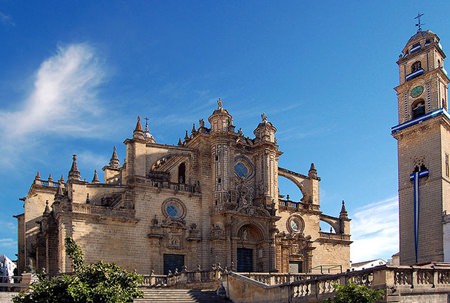It always strikes me as regretful that one of the world’s finest white wines, with a history of many hundreds of years, has become so hopelessly out-of-fashion apart from in its own country. In Britain, it has been a popular wine since Shakespeare’s time and throughout most of the twentieth century it was a popular pre-dinner drink among the more affluent classes. But sadly, these days it’s become associated with maiden aunts and dotty country vicars, or simply used to perk up the taste of a Christmas trifle. I refer, of course, to Sherry.
In Spain, it’s the preferred drink of bull-fighters. And here you’ll have to allow me a bit of poetic licence, because the word matador is not used on its own in Spanish and appears only in expressions like matador de toros. Sherry’s uniqueness comes from the fact that it’s made in one small corner of Spain. Nowhere else. Over the years, there have been many imitations but they were mostly pale shadows of the real thing.
 The Cathedral in Jerez de la Frontera (Photo: Will).
The Cathedral in Jerez de la Frontera (Photo: Will).
Sherry is made from white Palomino grapes grown near the town of Jerez de la Frontera in the region of Andalusia. The name Sherry is the anglicised version of Jerez, which itself is a modern version of the much older Xerez. Strangely enough, the city’s main football team continues to use this exotic-looking spelling. And talking of sport, Jerez also plays host to Grand Prix motorcycle racing every year. Andalusia is one of the hottest parts of Europe and it’s about as far south as you can go in Spain before wading into the Mediterranean.
When Spanish ships sailed the oceans during the Golden Age of exploration, they always carried a decent supply of alcohol, because water was usually disease-ridden and unreliable. Even so, ordinary wine deteriorated rapidly at sea especially in hot climates, so brandy was added to the barrels to fortify the contents. To this day, Sherry remains a fortified wine. It is heartening to know that when Ferdinand Magellan prepared to sail around the world in 1519, he spent more money on Sherry than on weapons. He sounds like my kind of captain.
There are several different types of Sherry, ranging from bone dry to staggeringly sweet. In its natural state, which is how most Spanish people prefer it, Sherry is almost transparent, completely dry and invariably enjoyed with food. The wines you’re most likely to encounter are Fino (clear and dry, with an earthy aroma of almonds); Manzanilla (paler and even drier, made in Sanlúcar de Barrameda); Oloroso (rich amber with an aroma of hazelnuts); Amontillado (somewhere between a Fino and an Oloroso) and Cream Sherry (sweet and unctuous). There are others, but you’re unlikely to find them around here.
The finest Sherries come from companies such as Croft, Sandeman, Williams and Humbert, Domecq, Hidalgo, Lustau and González Byass – the makers of the renowned Tío Pepe. Because Sherry is sold under brand names, consistency is important. This is achieved by blending wines from successive years in an extensive range of barrels known as a solera. After blending, something strange happens. As the new wine waits in its cask, a layer of natural yeast called flor sometimes develops on the surface. This phenomenon occurs almost nowhere else in the world.
Because of the blending process, most Sherries are non-vintage wines. In exceptional years, some wine is set aside for making Vintage Sherry but it’s very rare. It comes as a surprise to some people to know that that all Sherry should be served cold, as they do in Spain. This is especially true of dry ones.
Custer’s Fino Dry Sherry, Spain (Bt. 465 @ Foodland)
Bottled in Jerez, this gold-coloured wine has an aroma of raisins, almonds and olives, along with delicate hints of white fruit. It’s several shades darker than a Tío Pepe but surprisingly, it’s rather lighter in body, noticeably drier and a dash more acidity. The wine has a very long dry finish and is really rather elegant. If you prefer a typical dry Fino, especially as an apéritif, you’ll probably enjoy this wine. For some reason, this brand seems to be very popular in Scandinavian countries. Even so, this is bargain-basement wine. Foodland is one of the few supermarkets that offer a selection of Sherries which is good news because some other outlets have none at all. If you want to splash out on a classic, Foodland sell Sandeman Dry Sherry at Bt. 745 and the superb Tío Pepe at Bt. 1,399. However, if your budget doesn’t allow for these treats, there’s a very good alternative.
Bookmark Dry Apera, Australia (Bt. 362 @ Villa)
Not so long ago, they called this wine Bookmark Dry Sherry but nowadays the use of the name “sherry” is forbidden outside Jerez. Hence the rather strange name apera. Incidentally, the Angove story began in 1886 when a Dr Angove established a medical practice in Tea Tree Gully and began experimenting with vines and winemaking, initially as a tonic for his patients. I wish my doctor would try something similar.
This is a very pleasant wine, too, and at this price, a real bargain. A light straw colour, it has a rich, nutty aroma with almonds, marzipan, raisins, a hint of yeast and a pronounced tang of orange peel. The taste is full and fruity and there’s a soft mouth-feel with a good dash of rich acidity. There’s an amazingly long finish with floral overtones and hints of orange. The wine is not as dry as a typical Fino and its rich buttery taste reminds me of an Amontillado.
And why, I ask myself, does the smell of Sherry always remind me of Christmas? Perhaps it’s because long ago, Sherry was the family’s traditional drink at that time of year. I used to add a dash of orange juice to make it more palatable. This would make most Andalusian matadors as angry as the bulls they’re supposed to be fighting, but I was only eleven at the time.




